March 29, 2020
Dvořák Requiem, Jakub Hrůša in memoriam Jiří Bělohlávek
Hrůša, a close associate of Bělohlávek, conducted the Czech Philharmonic’s memorial to Bělohlávek in September 2017 (Dvořák Stabat Mater). The performance of Dvořák Requiem on this recording was made in September 2017 at the start of the Dvořák Festival in Prague, also in honour of Bělohlávek. Although Bělohlávek himself was only able to record the Dvořák Biblical Songs op 99 (with another Bělohlávek regular, Jan Martinik) this recording is effectively a monument to Bělohlávek, and a worthy successor to the rest of the Decca series. Hrůša’s Requiem, capturing the full emotional intensity of that memorial concert in the Rudolfinium, Prague, where everyone on the platform and in the audience had personal knowledge of Bělohlávek and what he meant.
Requiems commemorate the dead, and for those who believe, encapsulate the central tenet of Christianity. Dvořák’s religious beliefs were profound, shaping his Requiem as a testament of faith. The Kyrie, by far the longest part of the first section, is a funeral march, the pace measured and dignified. The strings create a reverential hush, but one lit by luminous, transcendental light. This reflects the text: “Requiem aeternum dona eis, Domine, et lux perpetua luceat eis”. The promise of eternal light, even in the depths of anguish. “Kyrie eleison” thus has context. In the second Requiem aeternum, a solo emerges, and the pace picks up: lines pulsate, as if in anticipation.
The Dies Irae marks a transition: powerful chords underline a sense of violent change. A trumpet calls forth, the “tuba mirum spargens sonum” whose baleful sound heralds the Day of Wrath that marks the End of Time and the mass resurrection of all who have died. Thus, the tenor part, with its prayer-like intonation, and the fierce outbursts from choir and orchestra. The plaintive Quid sum miser states that mankind is weak, but salvation lies through “Rex tremendae majestis”. With the Recordare, Dvořák’s identity re-asserts itself in the loosely Bohemian personality inn the orchestral line, here highlighted by the sensitivity of Hrůša and this orchestra who understand it so well. The soloists, Michael Spyres, Jan Martinik, Ailyn Pérez and Christianne Stotjin form an ensemble like a garland. With the Confutatis maledictus and the Lacyrmosa, (particularly beautiful singing and playing) this constant interplay of turbulence and tenderness creates inner momentum, intensifying a sense of forward thrust.
This underlines the structure of this Requiem, the first part building up to the second. With the Offertum, the bass part, haloed by harps and choir, suggests depth and profundity, the female soloists and tenor enhancing this new mood of confidence. “Sed signifer sanctus Michael reporesentet eas in lucern sanctum”. Vigorous rhythms replace the funereal tread of the first Requiem Aeterum. the trumpet now introduces a Hostias where the soloists ring out pure and the chorus (Prague Philharmonic Choir) very well parted. With the Sanctus, yet another change. As this Requiem reaches its conclusion, its spirit transforms. Even the Pie Jesu is affirmative, multiple voices together welcoming Eternal Rest. This Agnus Dei is a wonder, the luminous textures of the first Requiem Aeternum now illuminating the singing and playing transcendent glory. Delicately paced diminuendos create the image of heavenly peace. Truly “lux perpetua luceat eis”. And truly Hrůša’s Dvořák Requiem truly establishes the significance of the piece in our appreciation of the composer himself.
Dvořák’s Biblical Songs op 103 enhance the impact of the Requiem. The songs set texts from the Book of Psalms. The vocal line is dignified, even austere, emphasising the enduring power of these verses which have inspired people for thousands of years. The orchestral line is restrained, letting the voice ring out with Biblical portent. Bělohlávek and the Czech Philharmonic have the Dvořák idiom in their genes, bringing out the distinctive rhythms and character, which enlivens this performance without dominating. I’m very much taken with Jan Martinik, whose voice has natural richness and colour, and delivers with understated power. He worked very closely with Bělohlávek and the Národní divadlo and regularly featured in Bělohlávek’s numerous concerts in London. Definitely a recommended recording, even though there is much competition.
In this performance of Dvořák’s Te Deum op 99 recorded by Hrůša in December 2018, the brass are bright and assertive, the rhythms confident and distinctively idiomatic. There are echoes of the composer’s ninth symphony, but it is essentially a celebratory showpiece for large orchestra and massed voices and presented here with great verve. The baritone is Svatopluk Sem, another Bělohlávek favourite and Národní divadlo regular, and the soprano is Kateřina Kněžíkov. Much is made of the high-profile premiere in 1892, but the sad truth is that Dvořák was never paid. When a cheque finally arrived, it failed to clear. Oddly enough that fits in with the idea of a Requiem. No matter what worldly status might bring, at the end we all end up the same so what you believe might make a difference.
Anne Ozorio
Please also see more about the Bělohlávek Decca series
Monumental Josef Suk : Asrael Symphony
Janáček Glagolitic Mass, Sinfonietta
Life-affirming Smetana Ma Vlast
Dvořák Stabat Mater
March 28, 2020
Accentus stream full-length operas on Opernhaus Zürich website
A selection of opera and ballet productions that Accentus has recorded at
the Opernhaus Zürich and consequently produced will be streamed on the
opera house's website from Friday 27 March for every weekend up until early
June. Audiences can watch enrapturing, magical interpretations ofThe Land of Smiles, Alban Berg's Wozzeck, Verdi'sMessa da Requiem and Nabucco, Massenet's Werther, I Capuleti ei Montecchi by Bellini, Nutcracker
and Romeo and Juliet all from their living rooms.
These can be streamed on the Opernhaus Zürich website:
https://www.opernhaus.ch/spielplan/streaming/
image=http://www.operatoday.com/Accentus%20logo.jpg
March 26, 2020
Philip Venables' Denis & Katya: teenage suicide and audience complicity
A Venables opera is not a comfortable experience.
4.48 Psychosis
, which I reviewed in 2018, is drawn from Sarah Kane’s final full-scale
play, though it is a work which often seems less like drama and more like
opera in its theatricality. In one sense, this opera is almost like a
prelude to the drama of Denis & Katya. Parallels with Wagner
might not seem that obscure or unusual to make. There isn’t any link
between the dramatis personae that threads these works together; but very
like Wagner, there are motifs and themes which are common - and very
uncommon - to both. The orchestral forces differ between the two operas,
but what they share are spatial symmetry and a kind of Morse code in the
sound that is sometimes generated. If 4.48 Psychosis is about
psychological fragility, the descent into madness, a suicide note drenched
in the poetry of opera then Denis & Katya is almost the
obverse of this. There is nothing fragile here, rather it’s the tornado of
a psychological breakdown, a madness that is violent, a suicide note that
is played out in public and broadcast in a language that eschews the poetic
into something entirely demotic. One suicide is very private as we
experience a mind disintegrating; another suicide is entirely public as it
is played out over social media. Psychosis can be an internal civil war, or
it can be one that’s like a video game.
Both Kane’s 4.48 Psychosis and Denis & Katya are
autobiographical though in highly different ways and witnessed through very
different microscopes. Kane’s was a vast monologue, a torrential emotional
topography which ended up haunting and tragic from a deeply personal
perspective. Denis & Katya is entirely narrative based, though
the panorama we see through the webcam and lens of the website, Periscope,
is entirely voyeuristic. What violence and tragedy unfolds happens
exponentially - the greater the audience becomes, the more extreme the
action and drama becomes. It was never unavoidable during this period of
cabin fever that the complicity of a world-wide audience tagging each other
would be anything other than explosive in its outcome. The case of a virus
going viral. And, all that separates the audiences of this tragedy through
time is the notion of our distance to it. Whether it be the real time of
the events themselves, or the narrative describing the past, the voyeurism
of who is watching it is unchanged.
What obviously makes Denis & Katya more compelling - even for
Venables and Huffman to get on this particular bandwagon - is who Denis and
Katya were. Read newspaper cuttings from the time (a relatively recent
2016) and you’ll find these are a couple of Russian teenagers invariably
described as “beautiful”; almost all the photographs that exist of them
show them to be clearly in love with each other. What precipitates tragedy
in all love stories is disapproval, that love is somehow forbidden. The
parallel for the media was Romeo and Juliet but it could have been Tristan
and Isolde. Add in a shoot-out and aggressive, aimless hedonism and you
come closer to something like Gregg Araki’s The Doom Generation, although
perhaps the celebrity culture which these dysfunctional teenagers began to
crave resembled more Oliver Stone’s Natural Born Killers. But where it is
easy to find sensationalism and exploitation in a story about youth and
suicide Venables and Huffman are sensitive to their tragedy. This is an
opera about Denis and Katya but there are no Denis and Katya. Instead, the
events are narrated entirely by six characters, and performed by just two
singers.
Because of this what we get is a story that is second-hand at best. It is
derived from crime-based reconstructions, documentaries, interviews - and
some of it is fictionalised. Even the outcome itself is uncertain, a
suicide off camera, just as in all Greek theatre where tragedy often
happened off-stage. (This ‘unseen’ suicide has indeed been a source of
speculation and fake news ever since.) But there is nothing Sophoclean or
Aeschylean about this story except in the rewriting of the role and
function of the Greek Chorus. No longer narrating what the protagonists of
this drama are doing, they have become actors looking inwards on their
webcams, directing the action, no longer just spectators but ones who will
become deeply implicated in its outcome.
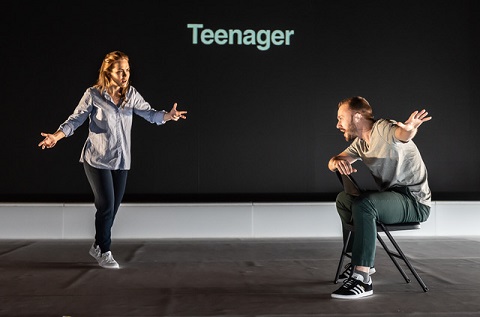 Emily Edmonds (mezzo soprano) and Johnny Herford (baritone). Photo credit: Clive Barda.
Emily Edmonds (mezzo soprano) and Johnny Herford (baritone). Photo credit: Clive Barda.
How far this approach to Denis & Katya blurs the lines between
theatre and opera is a thin one. The very concept of narration means much
of this opera is spoken rather than sung. This doesn’t always work in its
favour. I found the concept of translation, which was only needed for the
Russian text, overused when it was applied to the English text as well. As
a kind of vocal doubling it worked - but you can have too much of a good
thing. The opening prologue - which is long - sets the scene but is hugely
descriptive because there are no sets. Any kind of visual set requires very
little imagination from its audience - what you see is exactly that. A TV
set is described in some detail - where it is, the kind it is - but this is
important because it is a central part of their story. It isn’t so much
something they watch but something which becomes rooted in their violence -
it is blown apart with a shotgun and eventually thrown through a window.
Little of this could be shown on stage but works convincingly when
narrated.
Of the six roles, the Journalist and the Friend are the most important (the
former sung by a mezzo-soprano, the latter by a baritone) and these are
also the ones which are principally sung (though the opposite singer will
also perform spoken dialogue). The Neighbour and the Teenager are both
performed in Russian (again, with a simultaneous translation), and the
Teacher and Medic are both played as a duet. If this sounds a little
hectic, what it does is to keep the opera flowing rather as you’d expect
the events they’re describing to unfold with similar urgency.
Emily Edmonds and Johnny Herford were hugely impressive. If the opera
begins in a relatively straightforward way, requiring both singers to just
paint the scene for us, it rarely remains this easy for them. Sometimes the
sudden changes between one role and the next left the singers with little
margin for error. But it was the ability to switch between multiple roles
and make them sound distinctive which required a more creative and deft
artistry. Perhaps it wasn’t surprising that it was Edmonds’s The Neighbour
and Herford’s The Teenager (both of which are sung in Russian) which proved
the most distinctive. Herford’s Teenager was on the edge, brittle and
innocently touching, and his singing was everything about these things - a
very vivid contrast to Edmonds’s Neighbour who was an extraordinarily
powerful figure. Perhaps this power stems from the very nature of The
Neighbour - a character who has nebulous or ambiguous feelings about Denis
and Katya, who is uncertain about the events because she only sees them
from a distance. There is even something suggestive of Britten’s Mrs Sedley
in the part - even down to both roles being sung by a mezzo, and the more
sinuous scoring. If the Journalist and The Friend are the central figures
narrating the story, and these were beautifully done by Edmonds and
Herford, it’s tempting to argue that both The Teacher and The Medic might
have been roles better absorbed elsewhere.
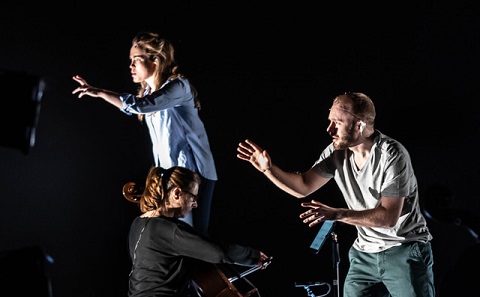 Emily Edmonds (mezzo soprano) and Johnny Herford (baritone), musicians (London Sinfonietta). Photo credit: Clive Barda.
Emily Edmonds (mezzo soprano) and Johnny Herford (baritone), musicians (London Sinfonietta). Photo credit: Clive Barda.
The orchestration for Denis & Katya is unusual, and even
tighter than Venables used in 4.48 Psychosis, which was limited to
twelve instruments. As with his first opera, Venables doesn’t use the
orchestra as a means to an end but as a significant part of the narrative.
The instruments blend with the voices, and the scoring is micromanaged to
reflect this. Scored for just four cellos - amplified by microphones - they
span the mezzo/baritone range well. More interestingly, and certainly the
intimacy of the Purcell Room acoustic helped, was the sheer aural weight
and potency of a quartet of them. With each cello arranged at a quarter
edge of the stage, they would play either in absolute unity or as a quartet
of soloists in their own right. The scoring is exceptionally well done, and
perhaps is no finer than in the music given to The Neighbour which is both
muscular and driven. The four cellists from the London Sinfonietta were
superb, the virtuosity limitless.
Much of Andrew Lieberman’s scenic and lighting design remains on the
minimalist side - extravagantly so for much of the opera’s seventy-minute
running time. This emptiness is almost entirely focussed on the stage
itself where only two chairs for the singers are used, the cellists
spatially placed at each corner. But this isn’t about what the audience
sees it’s about what they should imagine, not just in a staged sense but in
a psychological one. That what we do see (Pierre Martin’s highly
imaginative video design) relies entirely on the width of the Purcell
Room’s stage - that unbroken span of screen a vast computer monitor of
typed out messages, each letter accompanied by an electroacoustic click.
Only towards the end of the opera is there any real action as a train
begins to leave the Russian village of Strugi Krasnye where all of these
events have taken place. As the train gathers speed and travels one way,
the effect on the mind is to pull you the other. But this is, after all,
exactly what the opera has been about: motives, decisions, choices,
endgames and, in the end, unanswered questions.
What Venables and Huffman have given us in Denis & Katya is an
opera which defies the form. In doing so, it goes substantially further
than 4.48 Psychosis did. It is a tragedy, but its eponymous
characters never appear at all. The audience see what happens but are also
complicit voyeurs. And Venables and Huffman are no more nor less successful
than others have been in unveiling the enigma of what happened to Denis and
Katya, though this is not a major failing. If perhaps not as harrowing as
their first opera, it is a haunting and powerful work and, in a performance
as artistically compelling as this one, leaves a lasting impression.
Marc Bridle
Emily Edmonds (mezzo-soprano); Johnny Herford (baritone); Tim Gill, Adrian Bradbury, Zoe Martlew, Joely Koos (cellos, London Sinfonietta); Philip Venables (composer), Ted Huffman (Writer/Director), Ksenia Ravvina (Co-Creator), Andrew Lieberman (Scenic & Lighting Director), Millie Hiibel (Costume Design), Pierre Martin (Video Design), Rob Kaplowitz (Sound Design)
Purcell Room, Southbank Centre, London; 14th March 2020.
image=http://www.operatoday.com/%28Emily%20Edmonds%20mezzo%20soprano%20and%20Johnny%20Herford%20baritone%29%20Photo%20by%20Clive%20B%20%281%29.jpg image_description= product=yes product_title=Denis & Katya: Music Theatre Wales - Purcell Room, Southbank Centre, 14th March 2020 product_by=A review by Marc Bridle product_id=Above: Emily Edmonds (mezzo soprano) and Johnny Herford (baritone)Photo credit: Clive Barda
March 20, 2020
Royal Academy of Music appoints Brenda Hurley as Head of Opera
Brenda Hurley has been the Director of the prestigious International Opera
Studio (IOS) in Zürich since 2012. During her tenure, she has elevated the
IOS to become one of the leading young artist programmes, and singers,
including many Academy alumni, have gone on to perform in some of the
world’s finest opera houses.
Before her time with Zurich, Hurley coached singers for four seasons at the
Metropolitan Opera in New York, nine years at the Salzburg Festival, 15
seasons at Glyndebourne Festival (where she was awarded the Janni Strasser
Award for best repetitieur in 1995) and three seasons at English National
Opera. She has worked with a host of leading conductors including Sir Simon
Rattle, Sir Mark Elder, Sir Andrew Davis, Yannick Nézet-Seguin and Valery
Gergiev.
Hurley’s experience of coaching young singers is extensive. As a coach she
has worked with programmes including the Jette Parker Young Artists at the
Royal Opera House, Glyndebourne’s Jerwood Young Artist Programme, the
National Opera Studio in London, the Dutch National Opera Studio Amsterdam,
the New National Theatre Programme in Tokyo, the Sempeoper Dresden and the
Young Artist Programme at the Bolshoi Theatre.
Royal Academy Opera (RAO) functions as a small opera company and a bridge
to the profession, preparing exceptionally talented opera singers for
careers on the world's most prestigious stages. Its highly focused study
environment includes one-to-one tuition, coaching, group classes and opera
scenes, as well as fully staged productions that are regularly attended by
representatives from opera companies, artist agencies and the national
press. Hurley’s first production with Royal Academy Opera will be announced
in May.
Our outstanding in-house teachers and coaches are joined by pre-eminent
visiting artists such as Sir Simon Keenlyside and Ermonela Jaho, heads of
young artist programmes such as David Gowland (Jette Parker Young Artists
Programme) and members of staff from Glyndebourne and Garsington. Recent
visiting alumni have included Dame Felicity Lott, Brindley Sherratt, Allan
Clayton, Iestyn Davies and Lucy Crowe.
Students benefit from acting and movement classes, language coaching and
classes in many other areas of professional development, from audition
preparation to CV and biography support, fight classes and a stress
management workshop.
The Academy’s Principal, Jonathan Freeman-Attwood said:
‘I am thrilled that Brenda Hurley is joining the Royal Academy of Music at
the new Head of Royal Academy Opera. She is hugely respected as one of the
finest opera coaches, leaders and mentors to talented young singers all
over the world.
‘In her capacity as a visionary Director of the IOS in Zürich, Brenda has
forged an extraordinarily rounded and supportive educational environment in
which young artists thrive. It’s been a joy to observe how ex-RAO students
have developed under her guidance in the Opernhaus Zürich, and the prospect
of her arrival as a colleague at the Academy is extremely exciting.
‘I look forward to seeing RAO continue to go from strength to strength with
Brenda at the helm.’
The Royal Opera House launches a programme of free online content for the culturally curious at home
‘In this uncertain time, and as productions and events are postponed at the Royal Opera House and around the world, we have created a schedule of free broadcasts and live content that audiences can access for free anywhere, anytime across the globe, bringing both ballet and opera to every home and every device. This will include the following productions offered on demand and for free via the ROH’s Facebook and YouTube channels:
Peter and the Wolf , The Royal Ballet, 2010 - 27 March 2020, 7pm GMT
Acis and Galatea , The Royal Opera, 2009 - 3 April 2020, 7pm BST
Così fan tutte , The Royal Opera, 2010 - 10 April 2020, 7pm BST
The Metamorphosis , The Royal Ballet, 2013 - 17 April 2020, 7pm BST
Today we begin the rollout of this free programme of curated content, and invite our audiences to sign up for a free 30-day trial on Marquee TV, the international multi-genre performing arts streaming service. In collaboration with the Royal Opera House, Marquee TV will bring you the very best of world-class performances on demand.
A range of recent opera and ballet productions are available including La traviata and Alice's Adventures in Wonderland with new titles being added all the time.
Royal Opera House content is also available on radio, TV and online through our ongoing partnership with the BBC. Mayerling, Pappano's Greatest Arias and Darcey Bussell: Looking for Margot are all available on BBC iPlayer and can be watched at any time. Beethoven favourite Fidelio is also scheduled to be broadcast on Radio 3 at 6.30pm on Saturday 28 March.
In the coming days and weeks, we will roll out more of our free programme of broadcasts, so look out for updates and announcements via The Royal Opera House's social media channels and experience the best of the ROH from your living room.
image=http://www.operatoday.com/Royal%20Opera%20House%20exterior%20%28c%29%20ROH%2C%20Photo%20by%20Luke%20Hayes%202018%20%281%29.jpg image_description= product=yes product_title=The Royal Opera House launches a programme of free online content for the culturally curious at home product_by= product_id=Above: Royal Opera House exterior© ROH, Photo by Luke Hayes 2018
March 15, 2020
A new, blank-canvas Figaro at English National Opera
Well, if you’re struggling for ideas, how about a tabula rasa? Johannes Schütz’s set, already seen at Oper Wuppertal last April, is a white cube. Four doors at the rear facilitate conveyor-belt entrances and exits. The cube is hoisted (upstairs/downstairs? - never mind that the soon-to-be-wed Figaro and Susanna have been bestowed a shabby garret room by the Count …), and lowered. It’s washed with a lurid Kermit-green glow in Act 3, then swathed in bubble-gum pink. Confused and anxious protagonists, red-stockinged domestics and straight-backed valets traverse the space beneath, disappear behind, climb stairwells to the back doors, and - in the case of a panicking Cherubino - jump from its heights onto a gymnastics crash-mat, figuratively trampling gardener Antonio’s roses.
So, Hill-Gibbins wanted to avoid ‘grand ideas about setting, design or supplementary action’. That’s all well and good - perhaps, very good. We don’t need a sumptuous architectural embodiment of the Enlightenment ethos (such as David McVicar’s ROH production marvellously supplies); nor the sort of Minotaur mazing and mythic meddling in which ENO’s last Figaro ( Fiona Shaw's 2011 production , now presumably dead and buried) indulged. But, theatre does engage all the senses, and opera-theatre is as much about what we see as what we hear. The problem with Hill-Gibbins’ blank canvas is that it eradicates all context to the point that each and every of the characters might as well be Everyman Anywhere. Neither the historical droit de seigneur nor our own #MeToo register - no bad thing, perhaps, but how are we to empathise with these characters if they are just emblematic panto types scampering round, up and below a white shoe-box?
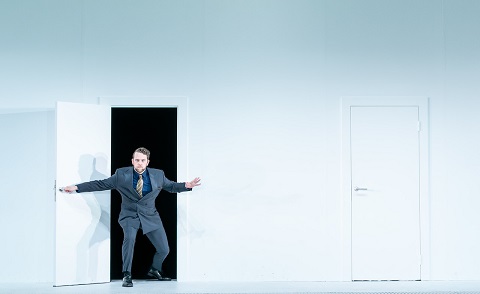 Johnathan McCullough (The Count). Photo credit: Marc Brenner.
Johnathan McCullough (The Count). Photo credit: Marc Brenner.
And, given the simplicity (to the point of non-existence) of the design, the actual execution of the drama is quite often fussy and overly busy. I had my teeth gritted during the Overture as the doors were flung open, characters posed for Instagram-ready selfies, and then dashed and disappeared, only to reappear ad infinitum. “It’s notBluebeard!” I wanted to shout. I could take a little commedia dell’arte ‘knowingness’, but the metatheatre quickly began to grate. So, Figaro’s resolve to outwit the Count, ‘Se vuol ballare signor contino’, witnesses the ritual dressing of the Count, with valets shuffling in with shoes and jacket, and Figaro himself adorning the over-ardent aristo with a garish neck-tie. Cherubino’s ‘Non so più’ is accompanied by a cartoonish door-opening slide show of the lives and loves of the opera’s sex-obsessed men and women. Then, there’s the problem of what’s ‘missing’ in this white vacuum: where’s the chair in which Cherubino is to hide when caught in Susanna’s room, for example? The doors which might be useful in emphasising the faux gentility/real poison of the Marcellina/Susanna duet, are less effective intrigues of the pivotal Act 1 Trio.
I was irritated most when the ‘comedy’ contradicted the music. In ‘Voi, che sapete’ Cherubino is misguided, perhaps, but utterly sincere. This is not the place for a boppy jive in which the Countess and Susanna join a ditzy adolescent in shoulder-waggling and elbow-churning. And why, if the opera is, as Hill-Gibbons professes to believe, about ‘character and relationships’, does he so often position duetting characters at opposite ends of the white cube in alienation and isolation, as they clutch and tug at the unforgiving and ungiving walls? Why does Act 2 end with some surreal body stroking and writhing? Why, if ‘supplementary action always feels superfluous’ according to our director, does the Countess have to undergo silent agonies in the suspended cube during the duet for the Count and Susanna at the start of Act 3? ‘[I]t wouldn’t work to add more ornamentation or decoration on top’, says Hill-Gribbins. Quite.
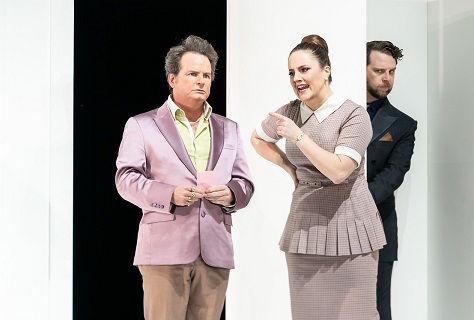 Colin Judson (Don Basilio), Louise Alder (Susanna), Johnathan McCullough (The Count). Photo credit: Marc Brenner.
Colin Judson (Don Basilio), Louise Alder (Susanna), Johnathan McCullough (The Count). Photo credit: Marc Brenner.
Thank goodness for some truly marvellous singing. Louise Alder’s Susanna is simply sublime. She nails the comedic mischief with a down-to-earth, no-nonsense realism that overcomes every directorial artifice. She’s pert and punchy, sometimes literally as Figaro finds to his peril, but also absolutely transcendent in Act 4’s ‘Deh vieni’: this aria was an absolute show-stopper. Despite being dressed in a hideously ugly shirt and then forced to don a Jimmy Krankie-style ‘military uniform’, Hanna Hipp shines as Cherubino. Elizabeth Watts isn’t necessarily a very sympathetic Countess, but given the way the production distances her, that’s perhaps not her fault, and she certainly has the technical command to convince if not beguile.
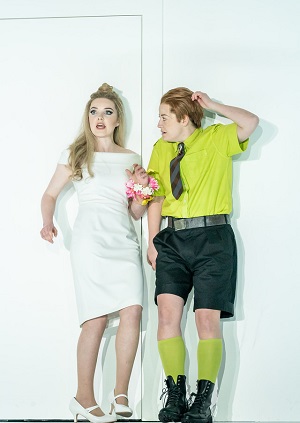 Rowan Pierce (Barbarina), Hanna Hipp (Cherubino). Photo credit: Marc Brenner.
Rowan Pierce (Barbarina), Hanna Hipp (Cherubino). Photo credit: Marc Brenner.
Božidar Smiljanić is a strong presence as Figaro, balancing wile, willingness and affection with well-projected, warm-toned candour. Johnathan McCullough’s Count has just the right mix of menace and misguided maladroitness. Colin Judson’s oleaginous Don Basilio - a sleaze ball in silk - made my skin creep, which is just as it should be! Judson - slathered in a the trademark suntan of the ‘orange people’ - demonstrated terrific diction and a wonderfully pertinent tonal nasality. I found Andrew Shore’s Bartolo far too burlesque: ‘La vendetta’, too slow and exaggerated, was a wobbly hoot. And, Clive Bayley’s Antonio did not venture beyond ‘stock’ clumsiness, though there was nothing wrong with that.
 Božidar Smiljanić (Figaro). Photo credit: Marc Brenner.
Božidar Smiljanić (Figaro). Photo credit: Marc Brenner.
Susan Bickley made Marcellina a character we could love rather than loathe, and to have Rowan Pierce in the role of Barbarina was an absolute joy: we cannot have to wait long for her Susanna, surely?
Kevin John Edusei made his debut in the pit. I wasn’t especially impressed. The tempi didn’t settle, too often stage and band were adrift (the raised cube probably didn’t help), and there was frequently a lack of clarity from the small orchestral forces. The continuo ensemble was, however, terrific.
At the close, the Count found himself excluded from the party as the production-defining doors slammed in his face. A metaphor perhaps for the doors that will surely close on the capital’s cultural life in the coming weeks. You’d better catch this Figaro while you can.
Claire Seymour
Figaro - Božidar Smiljanić, Susanna - Louise Alder, Count Almaviva - Johnathan McCullough, Countess - Elizabeth Watts, Cherubino - Hanna Hipp, Marcellina - Susan Bickley, Dr Bartolo - Andrew Shore, Barbarina - Rowan Pierce, Don Basilio/Don Curzio - Colin Judson, Antonio - Clive Bayley; Director - Joe Hill-Gibbins, Conductor - Kevin John Edusei, Set Designer - Johannes Schütz, Lighting Designer - Matthew Richardson, Costume Designer - Astrid Klein, Movement Director - Jenny Ogilvie, Chorus and Orchestra of English National Opera.
English National Opera, London Coliseum; Saturday 14th March 2020.
image=http://www.operatoday.com/ENO%202020%20Figaro%20title.jpg image_description= product=yes product_title=Mozart: The Marriage of Figaro - a new production at English National Opera product_by=A review by Claire Seymour product_id=Above: Louise Alder (Susanna, centre top) and ENO ChorusPhoto credit: Marc Brenner
March 14, 2020
Massenet’s Chérubin charms at Royal Academy Opera
Beaumarchais-Mozart’s hyper-sexed adolescent, Cherubino, speaks of love when dreaming, when awake, and even when there’s no one there to hear his radiant romanticising, inspired by burning desires he can neither understand nor control.
In the third of his ‘Figaro plays’, La mère coupable, Beaumarchais’s excitable young page enjoys a night of passion with the Countess Almaviva only for her to suffer pangs of guilt and dismiss her lover, sending him into spiral of depression, derring-do and death. With suicidal recklessness he runs off to battle and is mortally wounded. The Countess reads his dying words of regret and love; shortly after she finds she is pregnant with Cherubino’s child.
French playwright Francis de Croisset had other ideas. Chérubin, the eponymous protagonist of de Croisset’s 1901 ‘Figaro-sequel’ hasn’t changed much since his days spent panting in the Countess’s dressing-room or gallivanting with Barbarina in the nocturnal garden. Now a swaggering, swooning seventeen-year-old in Seville, he is looking forward to celebrating his birthday and his new military commission by inviting countesses, baronesses, the Duke’s mistress and the girl-next-door to his fête galante.
Jules Massenet was charmed by de Croisset’s Chérubin when he saw it at the Théâtre-Français and just two days later he had obtained the rights to the play in order to set it as an opera, which he termed a comedie chante, with the aid of de Croisset and Henri Cain. The resulting rococo confection, which bubbles with playful pastiche and parody, went down well with its first audiences in Monte Carlo in 1905 (the premiere took place, serendipitously, on 14th February), and subsequently was well-received in Paris. Fauré praised its Mozartian spirit and grace.
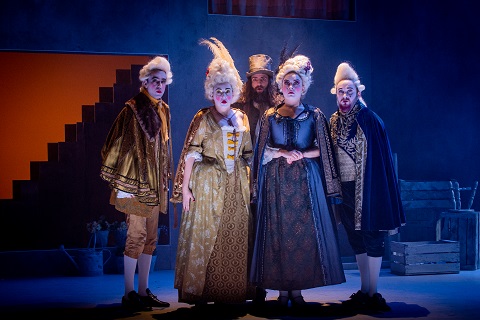 Photo credit: Robert Workman.
Photo credit: Robert Workman.
Requiring a large cast, and with copious juicy roles for several female voices, it’s a good choice for a student ensemble, and Royal Academy Opera have frothed up a flighty and frivolous evening of fun. Duels are threatened and diverted. Swords are unsheathed, sensuous serenades sung, and Spanish dances sashayed. Chérubin woos women from dawn to dusk, despite the warnings and guidance issued by his compassionate and wise mentor, The Philosopher.
Director James Hurley and designer April Dalton take a tongue-in-cheek glance towards the eighteenth-century. Period costumes are sumptuous, the rouge is slapstick and the bygone rococo world is filtered through bright modern lights. There’s a touch of Peter Greenaway in the juxtaposition of cool gentility and vibrant excess, as the angled grey walls of Dalton’s set reveal curtained niches of eye-popping hues. At the start, we might be at Orlovsky’s party, if only the large cast’s opportunities for hedonism were not curtailed by the constriction of the design’s small spaces. The back walls, which push the action quite far forward on the Susie Sainsbury Theatre stage, also bounce the sound out into the auditorium with energetic thrust: it’s a busy and boisterous production, and occasionally - for example, in the moonlight episodes of the second act - a little more contrast of light and shadow, laughter and serenity, might have been welcome.
However, these are minor misgivings. This second-night, second-cast performance was a delight of musical nostalgia, affectionate whimsey and charm. Massenet clearly enjoyed himself composing this opera and so the singers and musicians relished performing his exuberant score. Though, conductor Anthony Legge (currently Interim Head of Opera) didn’t obviously evince the lilt and grace of French comedy, he ran a tight ship and his instrumentalists played with terrific precision and verve. There were some lovely woodwind colours and plenty of Spanish flavour. Legge didn’t seem to give the singers much attention or guidance, but, then, they didn’t seem to need it.
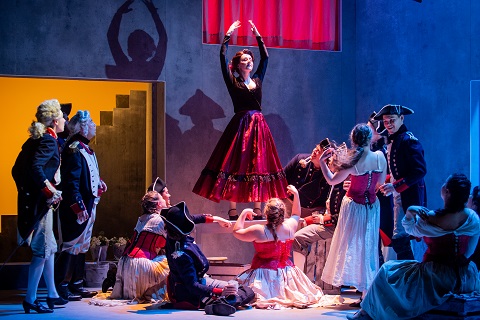 Grace-Marie Wyatt (L’Ensoleillad). Photo credit: Robert Workman.
Grace-Marie Wyatt (L’Ensoleillad). Photo credit: Robert Workman.
The three principal soprano roles were well differentiated and engagingly characterised. In the title role, Lithuanian mezzo-soprano Gabrielė Kupšytė glowed with dizzying charm and puppyish enthusiasm, by turns frisky, petulant and introspective. Kupšytė displayed gamine grace as the would-be Casanova, chest puffed out in faux-mature posturing. A thwarted opportunity for sword display resulted in a fit of pique and melancholy: Mozart’s young page seemed hardly to have ‘grown up’ at all. Infectiously ‘love-drunk’, Kupšytė’s first aria, ‘Je suis gris! Je suis ivre!’, dazzled with a lovely sheen and thrilling bloom, but there was moving and tender sincerity when the confused young lover asks The Philosopher to explain why the merest thought of a woman so inflames his heart with uncontrollable passion. Bass Ossian Huskinson was a strong, dignified presence as The Philosopher, displaying a warm, generous tone, and sonorously sharing his wisdom with his charge.
As the Spanish dancer, Ensoleillad, Grace-Marie Wyatt used the plush layers and fruity lower range of her soprano to show us why she had ensnared the Duke’s heart. Sensuous and impetuous, this Ensoleillad enjoyed the favours and admiration bestowed upon her but kept a cool head when required. Her aubade, ‘Vive amour qui rêve, embrasse, et fuit’, was beautiful, and Chérubin - still reeling from the heady scents of the sweet love-duet that they sang at the end of Act 2 - would have done well to heed her words: “Long live love that dreams, blazes and flees,/ Long live love that dies in one night.”
Samantha Quillish impressed in all three of RAO’s 2019 productions, most especially in the title role of Tchaikovsky’s Iolanta , and here she was outstanding as Nina, the ‘nice girl’ whom Chérubin overlooks as he chases his aristocratic darlings. Her act 1 aria was a lovely moment of simplicity and stillness amid the revelry and carousing, and in the final act - a sombre figure in black, as Nina prepares to enter a convent - she sustained a sense of sincerity when things took a sentimental turn.
In the comprimario roles of The Count and The Baron, James Geidt and Dan D’Souza were convincingly patrician and urbane, while Camilla Harris (The Countess) and Elspeth Marrow (The Baroness) were mischievously entertaining as two bored aristocrats in search of some fun. Maxwell Levy (Capitain Ricardo), Andrew Johnston (The Innkeeper), Peter Harris (The Duke) and Connor Baiano (Officer) made up the fine cast, and there was lively support from the 24-strong chorus who nimbly negotiated the steps, stairs and niches of the set.
When a rare moment of common sense throws Chérubin into Nina’s arms and the young lovers creep away, Massenet and his librettist have one last laugh. As Ricardo and The Philosopher wryly identify them as ‘Don Juan’ and ‘Donna Elvira’, the orchestra strikes up ‘Deh vieni alla finestra’. Will Nina become just one of the ‘mille e tre’ seduced Spaniards in Chérubin’s catalogue of conquests? It’s hard to believe: Massenet’s music is too sweetly sentimental, surely?
The esteemed nineteenth-century critic and scholar, Adolphe Jullien, an early admirer of Massenet, summed up the composer’s allure: ‘On leaving the theatre when this froth of sound has subsided, one feels a trifle embarrassed at having allowed one’s self to be carried away; and if one wishes to probe to the core this dazzling, shimmering music, it is easy to see that there is in it little substance and novelty. But when the curtain goes up again we promptly come under its spell once more, and again we feel the lively attractiveness of this fresh and sparkling music. A great magician in truth, is the composer of Chérubin.’
This production certainly sparkled with the spirit of make believe and held us under its spell.
Claire Seymour
Massenet: Chérubin
Chérubin - Gabrielė Kupšytė, L’Ensoleillad - Grace-Marie Wyatt, Nina - Samantha Quillish, La Comtesse - Camilla Harris, La Baronne - Elspeth Marrow, Le Philosophe - Ossian Huskinson, Le Comte - James Geidt, Le Baron - Dan D’Souza, Le Capitaine Ricardo - Maxwell Levy, L’Aubergiste - Andrew Johnston, Le Duc - Petter Harris, Un Officier - Connor Baiano; Director - James Hurley, Conductor - Anthony Legge, Designer - April Dalton, Lighting Designer - Ben Pickersgill, Movement Director - Victoria Newlyn, Royal Academy Chorus and Sinfonia.
Susie Sainsbury Theatre, Royal Academy of Music, London; Thursday 12th March 2020.
image=http://www.operatoday.com/Cherubin%20title.jpg image_description= product=yes product_title=Massenet: Chérubin (Royal Academy Opera) product_by=A review by Claire Seymour product_id=Above: Gabrielė Kupšytė (Chérubin) and ensemblePhoto credit: Robert Workman
March 12, 2020
Charles Wuorinen: June 9, 1938 – March 11, 2020
It is with regret that we announce the death of Charles Wuorinen, composer of over 270 works, virtuosic pianist, and conductor. He died on Wednesday, March 11 from complications after sustaining a fall in September 2019.
Wuorinen’s music of refinement, power, technical excellence and wide-ranging emotional pallet found a home in operas, ballets, symphonies, and chamber and vocal works of all combinations and instruments. Wuorinen’s last completed work was his Second Percussion Symphony, premiered in Miami in September 2019.
In recent years James Levine became a staunch advocate for Wuorinen’s music and commissioned five orchestral works including his Fourth Piano Concerto with Peter Serkin for the Boston Symphony Orchestra. Michael Tilson Thomas, a conductor whom Wuorinen worked with for much of his career, commissioned Bamboula Beach for the inaugural concert of the New World Symphony, and most recently Sudden Changes for the San Francisco Symphony.
The first composer Christoph von Dohnányi commissioned for the Cleveland Orchestra was Wuorinen, who produced Movers and Shakers. Oliver Knussen, a great interpreter of Wuorinen’s works, recorded A Reliquary for Igor Stravinsky, which enshrined musical fragments entrusted to Wuorinen at the Russian composer’s death by his widow, Vera Stravinsky.
Wuorinen wrote six works for the New York City Ballet including three scores inspired by scenes from Dante for Peter Martins, and Five: Concerto for Amplified Cello and Orchestra with the dual purpose of it being a cello concerto for his great friend and collaborator Fred Sherry.
Wuorinen’s works for the stage include operas on Annie Proulx’s Brokeback Mountain and Salman Rushdie’s Haroun and the Sea of Stories. Throughout his career Wuorinen displayed his mastery of vocal writing, setting texts from the Vulgate to contemporary writers such as James Fenton, James Tate, and John Ashbery.
Wuorinen had a strong interest in earlier music which is seen in such works as Delight of the Muses, written for the Mozart Bicentennial, Time Regained, which uses materials from Machaut, Dufay, Gibbons, and Mattei de Perugia, and The Magic Art: An Instrumental Masque drawn from the works of Henry Purcell.
In 1962 he co-founded The Group for Contemporary Music with Harvey Sollberger. The Group was the precursor of a large number of similar ensembles formed throughout America particularly in the early 1970’s, and its luminous performances were widely regarded as models to be emulated.
A prodigy who started composing at age five, Wuorinen was a polymath with interests in fractal geometry, astrophysics, Egyptology and Chinese calligraphy.
He was the recipient of many awards, fellowships, and honors including the Pulitzer Prize (for Time’s Encomium) and a MacArthur Fellowship, and he was a member of the American Academy of Arts and Letters. He is the author of Simple Composition, used by composition students throughout the world. His longtime publisher is C.F. Peters.
He is survived by his husband of thirty-two years, Howard Stokar.
image=http://www.operatoday.com/Wuorinen_Roberts.png image_description=Charles Wuorinen. Photo by Nina Roberts. product=yes product_title=Charles Wuorinen: June 9, 1938 – March 11, 2020 product_by=Press release from Aleba & Co. product_id=Above: Charles Wuorinen. Photo by Nina Roberts.March 11, 2020
The Operas of Sergei Prokofiev
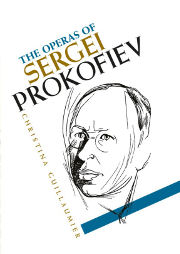 “The operas of Sergei Prokofiev (1891–1953) mark a significant contribution to twentieth-century music and theatre. Opera was Prokofiev’s preferred genre; not counting juvenile and unfinished works, he wrote a total of eight. Yet, to date, little has been published about the context, rationale or musical and compositional processes behind this output. While systematic studies of Prokofiev’s symphonies and his ballets exist, the operas have come under no such scrutiny. This book is the first in the English language to engage with the composer’s operatic output in its entirety and provides a contextual, critical and musico-analytical account of all of Prokofiev’s operas, including those juvenile works that are unpublished as well as the incomplete works composed towards the end of his life. It also includes synopses of the operas. Drawing on a wealth of archival material and other sources, the book provides the compelling untold story of Prokofiev the opera composer.”
“The operas of Sergei Prokofiev (1891–1953) mark a significant contribution to twentieth-century music and theatre. Opera was Prokofiev’s preferred genre; not counting juvenile and unfinished works, he wrote a total of eight. Yet, to date, little has been published about the context, rationale or musical and compositional processes behind this output. While systematic studies of Prokofiev’s symphonies and his ballets exist, the operas have come under no such scrutiny. This book is the first in the English language to engage with the composer’s operatic output in its entirety and provides a contextual, critical and musico-analytical account of all of Prokofiev’s operas, including those juvenile works that are unpublished as well as the incomplete works composed towards the end of his life. It also includes synopses of the operas. Drawing on a wealth of archival material and other sources, the book provides the compelling untold story of Prokofiev the opera composer.”
March 8, 2020
Edward Nelson Wins 2020 Glyndebourne Opera Cup
Edward Nelson, 31, grew up in a non-musical family, with the exception of his uncle who used to take him to concerts. Growing up he took part in a variety of performing arts including jazz, classical piano and musical theatre before dedicating himself to opera. He recently made an acclaimed European debut at Norwegian National Opera as Pelléas in Debussy’s Pelléas et Mélisande after learning the role in just four weeks.
During the Glyndebourne Opera Cup final, Nelson performed two dramatic arias from Ambroise Thomas’s Hamlet before sealing his win with a spectacular performance of the show-stopping ‘Largo al factotum’ aria from The Barber of Seville.
He was presented with his prize by Dame Janet Baker, the competition’s honorary president, who sat on the prestigious jury alongside fellow opera legends Sumi Jo, Sir Thomas Allen, and Dame Felicity Lott and top industry professionals. The competition was produced for Sky Arts by Factory Films and was presented by Chris Addison and Danielle de Niese.
As part of Glyndebourne’s commitment to diversity in the Glyndebourne Opera Cup, Sky Arts offered a bursary for BAME and Financially Disadvantaged contestants, which was claimed by a quarter of the singers who reached the semi-finals and a third of the finalists.
Six singers competed at the final for the top prize of £15,000 and the guarantee of a role within five years at one of the top international opera houses represented on the competition’s jury. They were accompanied by the London Philharmonic Orchestra, conducted by the up-and-coming Canadian conductor Jordan de Souza.
Second Place went to British soprano Alexandra Lowe, 28, while taking Third Place was American tenor, Eric Ferring, 27.
The Audience Prize, voted on by the live audience at Glyndebourne, was awarded to Chinese soprano Meigui Zhang, 26, and the Ginette Theano Prize for Most Promising Talent, was presented to South Africa mezzo-soprano Siphokazi Molteno.
The Glyndebourne Youth Jury, made up of young singers aged 16-21 who have taken part in Glyndebourne talent development and youth opera programmes, awarded their prize for the most engaging and communicative performance to South Korean tenor Sungho Kim.
Stephen Langridge, Glyndebourne’s Artistic Director and chair of The Glyndebourne Opera Cup jury, said: ‘All of the finalists performed to an extremely high standard but Edward Nelson’s dramatic flair and vocal elegance set him apart on the night and made him our worthy winner.’
Dame Janet Baker, honorary president of The Glyndebourne Opera Cup, said: ‘Sometimes the differences between talented singers are very small indeed; this was the case tonight. Both the semi final and the final stages produced technical singing of quality and all the singers involved can go home with heads held high knowing they have done themselves justice.’
The final of The Glyndebourne Opera Cup was broadcast live on Sky Arts and is available to watch on demand.
image=http://www.operatoday.com/Edward%20Nelson_photographer%20Richard%20Hubert%20Smith%20%281%29.jpg
image_description=
product=yes
product_title=2020 Glyndebourne Opera Cup
product_by=
product_id=Above: Edward Johnson
Photo credit: Richard Hubert Smith
March 7, 2020
Bluebeard’s Castle, Munich
By comparison, Giacomo Puccini’s exactly contemporaneous one-acter, Gianni Schicchi, had nearly 40. Bluebeard is consistently overlooked even though it boasts one of the great orchestral scores of the 20th century and a libretto based on a grippingly eerie tale of considerable existential depth. In an era of tight budgets, moreover, it requires just two lead singers, no chorus and a unit set.
Click here for access to a video stream relating to this production. (available through March 10, 2020)
One reason for this neglect, aside from the need to sing in Hungarian, is that companies struggle to find another one-acter to pair with Bartók’s intensely dramatic and uniquely colored work. Playing the gloomy Bluebeard before the intermission and the effervescent Schicchi afterwards, as some do, is only one of many unsatisfactory solutions.
A subtler problem is posed by the opera’s politically incorrect libretto, written by Béla Balázs, one of the composer’s close friends and a leading Hungarian intellectual of the day. In this retelling, Bluebeard (Kékszakállú, in the evocative Hungarian) is the quintessential strong silent male, a solitary warrior or artist, who resists a loving (but loquacious) young bride’s efforts to pry into his private life—worst of all, he seems to think, into his memories of intimacy with other women. In the end, he can’t cope and locks her away with past conquests in some dark corner of his mind.
Bartók was an intensely private person, so the story may have resonated with him. For 21st century spectators, however, the conceit seems to rest on dated gender stereotypes and a Victorian view of marriage in which honest openness (at least for a man) is unexpected and unwelcome.
In a much-praised new production for the Bayerische Staatsoper (a broadcast of which remains available on the Bavarian State Opera website), the award-winning British director Katie Mitchell addresses both problems in an original way. To open the evening, the orchestra plays the Concerto for Orchestra, another celebrated score written by Bartók exactly a quarter century after the opera. The Bayerisches Staatsorchester (a BMW among pit bands) performed brilliantly under the young Ukrainian, Oksana Lyniv—until recently an assistant to Generalmusikdirektor Kirill Petrenko and now Chief Conductor at the opera in Graz. Her rendition highlights subtle echoes of the earlier work.
During the Concerto, a film by Grant Gee is shown, which rewrites the backstory of the libretto. Bluebeard is no longer a serial monogamist who hopes the next marriage will work, but a psychotic sadomasochist who drugs and kidnaps women, then imprisons them in his cellar. And Judith is not a naïve bride who tries to get her guy to open up, but a police detective who goes undercover, impersonating the type of woman Bluebeard favors in order to entrap him. Instead of being locked up with the ex-wives, she shoots him dead.
This revision renders the opera politically correct in a “Me, too” era. Judith is now an active female role model who stands up to oppression and takes control of her life, while Bluebeard is criminally insane, so, one presumes, deserves what he gets. This also renders the plot more “realistic,” at least in the 21st-century Hollywood sense, in which bad guys are irrepressible monsters and good guys do what needs to be done.
As is so often the case in European operatic productions today, however, reworking the plot inserted superficially realistic detail at the expense of existential depth. Balázs and Bartók expected more. Their libretto, sexist though it may be on the surface, is a classic tragedy. The spoken prologue—often omitted, as in Munich—places the drama inside the characters’ heads.: “Raise the curtain of our eyelids. Where is the stage: outside or within?” Bluebeard and Judith are opposites who attract, thus unwittingly fall into a horrifying trap of their own making. No one gets what they want.
Having banished the suspense that comes from this psychological tension, the Munich production had little choice but to replace it with a series of arbitrary external obstacles, much in the manner of “Made for TV” crime thriller. Will Judith unknowingly take a swig of the drugged drink? Can she keep her gun hidden from Bluebeard? Will she stay in character long enough to get to the last door? Can she detain Bluebeard long enough for the other women to make their escape?
Refocusing the plot on such trivialities diminishes the dramatic stakes and undermines Bartók’s music. This is evident from the start: the film by Gee—who seems never to have worked in opera before—is distractingly unsynchronized with the Concerto, suggesting that no one with even a minimally musical ear was involved. So it continues. The melancholy final bars of the opera, after Bluebeard’s final gloomy words “Darkness, darkness,” make no impact. Rather, Judith stares at Bluebeard’s body, lost in thought. But about what need she think? Why does she not just clean her gun, fill out the paperwork, and reflect on a hard day at the office? Other divergences between music and production are evident even in the carefully edited film version on the Bavarian State Opera website.
To be fair, the production does have (in addition to the fine orchestral playing) two offsetting virtues. One is a dramatically gripping set design by Mitchell and Alex Eales. Small rooms open up one by one, ever lower across the stage, closing successively behind Judith as she descends to the lowest reaches of Bluebeard’s castle. The motif of small rectangles recalls the celebrated premiere production of George Benjamin’s Written on Skin, which Mitchell directed.
The second virtue is the singing of two accomplished Swedes: bass/baritone John Lundgren and soprano Nine Stemme. Both sing with satisfying precision, power and elegance—and in passable, if hardly idiomatic, Hungarian. To be sure, almost all singers sound slightly uncomfortable in these roles: few basses with voices rich, deep and dark enough to convey Bluebeard’s lonely melancholy can also reach Bartók’s high notes, while few mezzo-sopranos with the power to project over Bartók’s large orchestra also convey Judith’s youth and hit (at least briefly) a high C. Lundgren was more of a bass-baritone: comfortable at the top, heroically beautiful in the middle, but rarely gloomy. Stemme, today one of the world’s leading Wagnerian dramatic sopranos, has a heavier voice with which she hardly projects innocence, though this was perhaps appropriate to the production’s reinterpretation. Overall, one is unlikely to hear this opera sung better today.
Andrew Moravcsik
Béla Bartók: Concerto for Orchestra. Bluebeard’s Castle
Nina Stemme: Judith; John Lundgren: Bluebeard. Oksana Lyniv, Conductor. Katie Mitchell, Stage Director.
image=http://www.operatoday.com/Bart%C3%B3k_B%C3%A9la_1927.jpg image_description=Béla Bartók, 1927 [Source: Wikipedia] product=yes product_title=Judith: Concerto for Orchestra; Bluebeard’s Castle product_by=A review by Andrew Moravcsik product_id=Above: Béla Bartók, 1927 [Source: Wikipedia]March 3, 2020
The Queen of Spades at Lyric Opera of Chicago
Sir Andrew Davis conducts the Lyric Opera Orchestra in the gripping score and the Lyric Opera Chorus is prepared by its Chorus Master Michael Black. The central role of Gherman is sung by Brandon Jovanovich. Lisa who develops into a gradual emotional attachment for Gherman, is sung by Sondra Radvanovsky. Both artists delve into the portrayal of their characters with an intensity that demands attention from the audience. Also giving performances of urgency and commitment are Lucas Meachem as Prince Yeletzky, Elizabeth DeShong as Pauline, Jane Henschel as the Countess, Samuel Youn as Count Tomsky, and Jill Grove as their Governess. The production was directed originally by Richard Jones; the revival is directed by Benjamin Davis. Making her debut at Lyric Opera in these performances is Ms. Henschel.
The Lyric Opera Orchestra is led by Davis with sensitive shaping through the hauntingly lyrical introduction, just as the interplay of lighting and scrims draws the spectator into the lives and minds of the characters. Groups and smallish crowds alternate with individuals in the opening scene staged in a public park in St. Petersburg. The lively choral passages of nannies and their youthful charges give way with a smooth transition to the conversation of several offices now alone in the park. During the course of this scene the group of officers is variously seated on three uniformly placed benches, such feature suggesting a parallel between the depiction of public space and the fixation of the individual. At the entrance of Gherman change in the personality of the protagonist is noted by his fellow officers. In the dialogue between Count Tomsky and Gherman Mr. Youn succeeds admirably at depicting the compatriot bent on learning Gherman’s secret reserve. In the latter role Mr. Jovanovich creates an astounding figure: at first irritable and withdrawn, in response to Tomsky’s urging Gherman’s confession of his love for an unidentified, noble maiden proceeds into an opposing trajectory. In his determined yet admittedly hopeless focus on this attraction Jovanovich moves nervously from one bench to another of the three, his voice shifting convincingly from lyrical and dream-like statements to impassioned outbursts making use of head-tones to indicate excitement or despair. Once Prince Yeletzky announces his intention to marry, Gherman realizes that the object of his desire is even further from reach. Lisa and her grandmother, the Countess, appear in this public sphere, so that Gherman is now fully aware of his position. Once the story of the Countess’s youth in Paris - along with the intrigue of the secret three cards - is told, the protagonist’s obsession can here scarcely be contained.
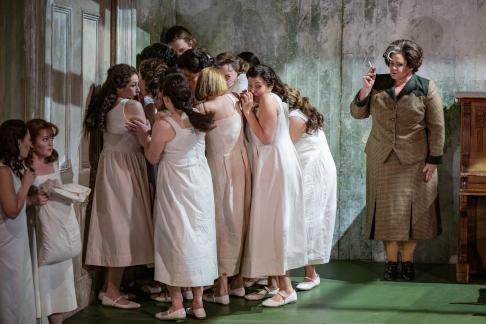 Jill Grove, Elizabeth DeShong, and Sondra Radvanovsky
Jill Grove, Elizabeth DeShong, and Sondra Radvanovsky
In the following scene the private interior of the noble household predominates. Lisa and her sister Pauline sing for their circle of intimates, the voices of Radvanovsky and DeShong blending in graceful arching lines. When subsequently alone in this scene, Radvanovsky’s impassioned self-examination shows a vastly contrasting approach. While she struggles to comprehend her diminished feelings for Yeletzky and an undeniable attraction to Gherman, Radvanovsky’s soaring top notes accelerate as her excitement at the thought of the officer persists. The encounter between Lisa and Gherman, who has secretly entered her room, intensifies until Jovanovich sings in terms of despair. The final moments of the act seal a union which cannot help but lead to a downward slide for the protagonists.
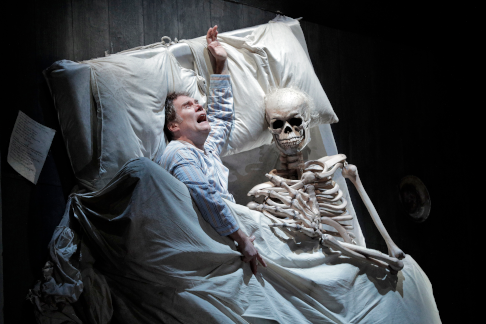 Brandon Jovanovich
Brandon Jovanovich
In the second act social festivities at first predominate. When alone together Yeletzky attempts to plead his cause with Lisa, whose emotional distance he senses. In Yeletzky’s well-known aria Mr. Meachem sings with a lush, romantically infused line, so that his words should melt the heart of his beloved. Yet the stage-blocking indicates the futility of this lyrical reminder. At the start of the aria, the two characters stand together, by the close of Meachem’s wistful lines, they remain at opposing corners of the stage. With Lisa’s intervention Gherman is later able to gain access to the Countess’s chamber where he plans to confront her after the social event. Here Jovanovich moves as though one possessed while he remains concealed until alone with the Countess. His threats to obtain the secret of the cards are as credible as his dejection at not learning the secret when the Countess dies of fright.
The third act brings Ghernan’s obsession to an inevitable conclusion. As he reads a letter from Lisa in his barracks Jovanovich depicts his character as oddly and uncharacteristically calm. Once visited by the ghost of the Countess, Gherman’s demeanor changes. When Lisa attempts to appeal to his presumed devotion, Jovanovich ignores her in both thought and speech. Radvanovsky’s final lines before suicide are heart-rending. In the final scene in the gambling parlor Gherman realizes, of course, that he has been tricked by the spirit of the Countess. His suicide on a circular platform of the gaming table recalls the position of the three benches in the opening scene. Obsession reaches its inevitable conclusion in this stunning production and cast at Lyric Opera of Chicago.
Salvatore Calomino
image=http://www.operatoday.com/Lucas%20Meachem_Sondra%20Radvanovsky_THE%20QUEEN%20OF%20SPADES_Lyric%20Opera%20of%20Chicago_c.Cory%20Weaver.png
image_description=Lucas Meachem and Sondra Radvanovsky [Photo © Cory Weaver]
product=yes
product_title=The Queen of Spades at Lyric Opera of Chicago
product_by=A review by Salvatore Calomino
product_id=Above: Lucas Meachem and Sondra Radvanovsky
Photos © Cory Weaver
WNO revival of Carmen in Cardiff
Of course, Bizet’s brightly lit score has all the atmosphere, vibrant colours and exotica of the Spain he never visited, and the strength of its text means it can survive even the most bizarre transpositions. This production certainly brings a new approach and rather than just project Carmen as a sexual predator, she’s cast as a working-class girl, one whose poverty brings her close to an underclass of uneducated, virtually lawless drug pedlars and gunrunners.
It’s this sense of deprivation and unruliness that influences both Davies and designer Leslie Travers whose set comprises a three-tiered curve of slummy apartments facing an unfinished courtyard with surrounding steel fencing. Grim as it is, the whole bears kinship with a favela, cleverly conveying a barracks (with family accommodation - even a brothel), cigarette factory or more probably a drug-smuggling plant, Lillas Pastia’s mountain tavern and a suggestion of a bullring. Much of the success of this is achieved through Gabriel Dalton’s costumes and Oliver Fenwick’s subtle lighting.
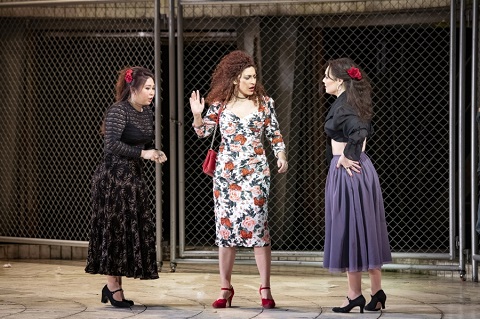 Haegee Lee (Frasquita), Julia Mintzer (Carmen) and Angela Simkin (Mercédès). Photo credit: Richard Hubert Smith.
Haegee Lee (Frasquita), Julia Mintzer (Carmen) and Angela Simkin (Mercédès). Photo credit: Richard Hubert Smith.
So far so good in its transposition from 19th-century Seville to a contemporary, non-specific location in Brazil. And so far, so good too, in its limited way, to focus on Carmen as a product of her environment. But Bizet’s masterpiece not only illuminates those at the bottom of the heap and the tensions between free will and restriction (consider all the steel fences), but charts the destructive power of obsession, the psychological plunge of Don José from decent lad to addictive, jealous and ultimately rejected lover.
Directorial novelty for one of the most performed operas in the repertoire is welcome, in fact it’s virtually a necessity. But so is a mezzo who can offer an essential mix of physical allure and danger. Despite striking looks and a vivid stage presence, Julia Mintzer never quite raised the emotional temperature; her devil-may-care wantonness was lukewarm and her somewhat plummy ‘Habanera’ made little impact. She possesses an attractive voice, but gypsy grit and growl is largely absent, and when the temptress in her finally emerges in the ‘Seguidilla’ her vocal projection is limited. It was not until we reached Act Two’s tavern duet, ‘Je vais danser’, that a light and flexible voice charmed the ear.
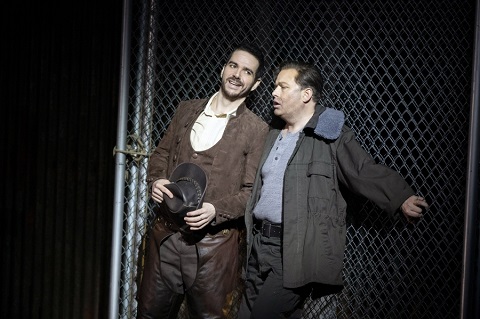 Giorgio Caoduro (Escamillo) and Peter Auty (Don José). Photo credit: Richard Hubert Smith.
Giorgio Caoduro (Escamillo) and Peter Auty (Don José). Photo credit: Richard Hubert Smith.
A well-cast Giorgio Caoduro as Escamillo brought smouldering looks and plenty of swagger. His rich, gnarly baritone - pushing a little too hard in the second act showpiece - found more even tone in his confrontational duet with Don José, sung with impressive ease by the lyric tenor Peter Auty. His was a portrayal of gathering intensity, delivering an impassioned ‘Flower Song’, and by Act Four his implicit doom was a mixture of rage and hopelessness. Chemistry between Auty and Elin Pritchard as the jilted Micaëla made clear shortcomings elsewhere. Her wide-eyed innocence was matched by a voice of homespun simplicity; operatic heft traded for sweetly calibrated lyricism.
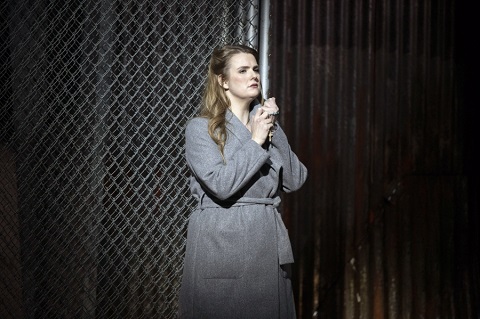 Elin Pritchard (Micaëla). Photo credit: Richard Hubert Smith.
Elin Pritchard (Micaëla). Photo credit: Richard Hubert Smith.
Prominent among the remaining cast are the bright, complementary voices of Hagen Lee and Angela Simkin as Frasquita and Mercédès faring well in the fortune-telling sequence, while John Savournin and Ross Ramgobin make their mark early on as Zuniga and Moralès. There’s robust singing from the Chorus and notably from some superbly trained school children whose jewel-like voices and conspicuous enthusiasm leaves a vivid impression. In the pit Harry Ogg drove through the score with a zeal that generated some startlingly fast tempos - a steeple chase of an overture and a rushed Act 3 prelude will hopefully gain some poise in time - but the orchestra responded with suitably clean, zesty playing. If you don’t mind the distracting dance episodes and the sludgy colours, this Carmen is worth seeing and in time its personal dramas will burn more fiercely.
David Truslove
Carmen - Julia Mintzer, Don José - Peter Auty, Escamillo - Giorgio Caoduro, Micaëla - Elin Pritchard, Zuniga - John Savournin, Moralès - Ross Ramgobin, Frasquita - Hagen Lee, Mercédès - Angela Simkin, Dancaïro - Howard Kirk, Remendado - Joe Roche, Director - Jo Davies, Conductor - Harry Ogg, Revival director - Oliver Lamford, Set designer - Leslie Travers, Costume designer - Gabrielle Dalton, Lighting designer - Oliver Fenwick, Movement director - Denni Sayers.
Welsh National Opera, Wales Millennium Centre, Cardiff; Thursday 27th February 2020.
image=http://www.operatoday.com/Revival%20Carmen%20WNO%20title.jpg image_description= product=yes product_title=Bizet’s Carmen: WNO in Cardiff product_by=A review by David Truslove product_id=Above: Giorgio Caoduro (Escamillo), Julia Mintzer (Carmen) and WNO EnsemblePhoto credit: Richard Hubert Smith
March 2, 2020
Lise Davidsen 'rescues' Tobias Kratzer's Fidelio at the Royal Opera House
After all, Beethoven was 19-years-old at the time of the storming of the Bastille, and in 1805, when the composer first presented his three-act Leonore one would have needed to be politically illiterate not to sense that an opera trumpeting such ideals would be associated with the spirit, if not the historical actualities, of the Revolution.
Similarly, no one would challenge the suggestion that Fidelio has dramaturgical, and generic, ‘issues’ that a director might seek to resolve in their own way. The opera’s troubled evolution caused Beethoven considerable labour and unrest, and the Fidelio that was performed in Vienna on 23rd May 1814 certainly didn’t solve the problems of the earlier three-act (1805) and two-act (1806) Leonores which preceded it. Even after eleven years and four different overtures, Beethoven was still lamenting that the opera needed wholesale re-writing.
So, there is nothing surprising or objectionable about Tobias Kratzer’s presentation, in this new production for the Royal Opera House, of Act 1 of Fidelio as a representation of a crucial juncture in the history of political ideals and events. Blazoned upon the curtain-drop is the Revolutionary motto, “Liberté, égalité, fraternité”, against a video-projection background of … well, us. Okay, leaving aside the matter of whether the ROH stalls audience is a fitting emblem of Revolutionary ideology, it’s perhaps not amiss to remind us that the upholding of such values requires us to step up to the breach. And, it’s a reminder that is slapped on with a trowel in Act 2.
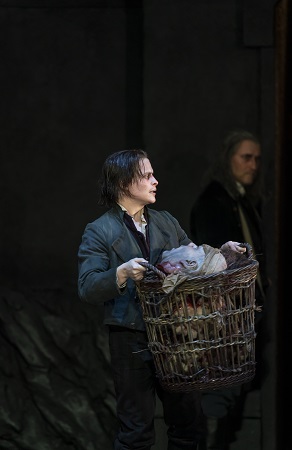 Photo credit: Bill Cooper.
Photo credit: Bill Cooper.
And, so, Act 1 unfolds with realistic Terror. No matter that the energetic curtain-raiser overture that Beethoven finally plumped for after years of compositional agonising has little of the musico-dramatic relevance and impact of his preceding efforts. Kratzer uses it as a musical background to head-rolling violence - literally, as a blood-dripping basket is heaved into designer Rainer Sellmaier’s claustrophobic prison courtyard, for bereaved widows to retrieve the guillotined heads of their rebellious, truth-speaking husbands. When the prison warden’s daughter, Marzelline, arrives bearing a wicker basket of laundry, the parallel is discomforting: violent retribution is simply part of the day’s housework.
The comic domesticity of the opening scenes has been criticised for its disjuncture with the heroic exploits and virtuous redemption which ensue. Kratzer sets about trying to smooth over the schism - though the sliding forth of Rocco’s private rooms surely presents some sight-line issues to those seated on the right of the auditorium.
Though Rocco and Marzelline are descendants of eighteenth-century buffa, Kratzer underplays their obvious and comic self-interest: such egoism would obstruct the heroic virtue that he is intent upon them displaying subsequently. The first few numbers of Act 1 do not establish the world of the ‘old regime’. The bickering of Marzelline and Jaquino is unsettling rather than peevish, and the tension is tautened by Fidelio’s incessant knocking at the door. Marzelline should be a foil for Fidelio/Leonore’s virtue and constancy. Here, she is certainly not her father’s daughter. And in any case, Rocco ‘Gold aria’ does not seem to establish pecuniary self-interest as more important than his role as a paterfamilias.
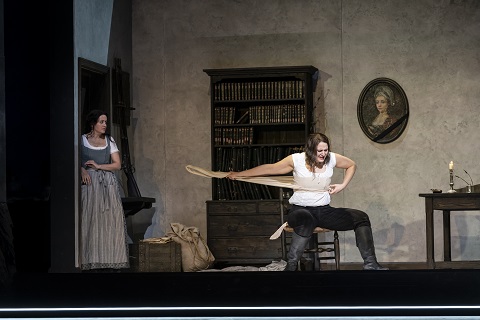 Amanda Forsythe (Marzelline) and Lise Davidsen (Fidelio). Photo credit: Bill Cooper.
Amanda Forsythe (Marzelline) and Lise Davidsen (Fidelio). Photo credit: Bill Cooper.
Proceedings begin to turn awry when Fidelio unwraps his/her breast-swaddling and is espied by the disillusioned Marzelline. Surely, the game is up? But, no, this Marzelline is inspired to her own heroic course of action. There are other obstacles to dramatic fluency, not least the over-loading of the spoken dialogue with text drawn from Beethoven’s contemporaries Georg Büchner (mainly from Danton’s Death) and Franz Grillparzer.
At the end of Act 1, the descent to the dungeons, where Rocco and Fidelio are to dig the grave of the prisoner prior to Pizarro’s arrival and assassination of his nemesis, is in this production an ascent into the light. That’s to say, the darkness is all within. Lighting Designer Michael Bauer confronts us with a glaring whiteness. Brechtian alienation reigns. The purpose of the blinding neon frame is revealed. At the start of Act 2 we find ourselves once again watching ‘ourselves’, this time in the form of the ring of present-day, grey-suited spectators - seated in a council chamber? or, drawing-room? - who stare at the shackled figure of Florestan, prone upon a slate mound, their shocked, disgusted, self-castigating expressions writ large in the back-wall video projections.
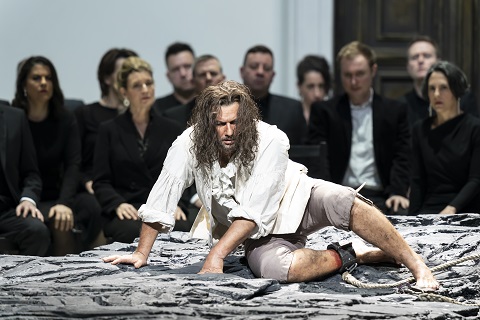 Jonas Kaufmann (Florestan). Photo credit: Bill Cooper.
Jonas Kaufmann (Florestan). Photo credit: Bill Cooper.
Dramaturg Bettina Bartz gives an account, sometimes persuasive, of the directorial thinking, and suggests that in Act 2 Beethoven ‘depicts an almost timeless space in which interpersonal and societal issues are played out’. Well, one might say, there’s still a ‘rescue opera’ underway. Watching the flinches and cringes - inspired as much by reluctantly acknowledged guilt as by the physical stench and unsightly sores - as Florestan thrusts himself towards his ‘audience’, as far as his shackles allow, might well be as discomforting as intended. But, it’s also distracting: do we want to be diverted by an onlooker surreptitiously unwrapping and devouring a chocolate bar as Florestan confronts us with a musical vision of man’s inhumanity and capacity for resistance, revolt and redemption? Does this really tell us anything about ourselves, or about Beethoven, or Fidelio?
Other directorial interventions in Act 2 are even more problematic. It is, after all, conjugal fidelity which distinguishes Leonore from the economically self-interested Marzelline. The opera’s virtue is reserved for Florestan and Leonore: in an outburst of quasi-mystical religious ecstasy, Florestan has an apparition of his wife as an angel, ‘Standing by my side to comfort me … To lead me to freedom in the kingdom of Heaven’. The synonymity of conjugal love with republican virtue is destroyed in this production by Kratzer’s decision (spoiler alert) to make Marzelline the agent of liberation. Leonore is denied the gun with which to forestall Pizarro’s villainy: that role is assigned to the pistol-wielding, trumpet-fanfaring Marzelline.
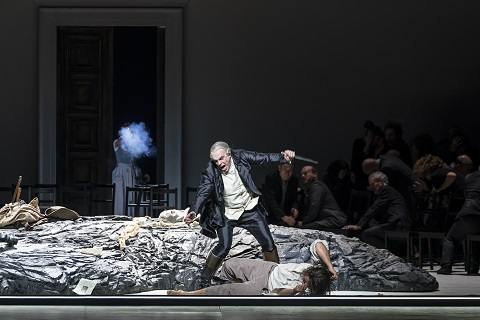 Amanda Forsythe (Marzelline), Simon Neal (Don Pizarro), Jonas Kaufmann (Florestan). Photo credit: Bill Cooper.
Amanda Forsythe (Marzelline), Simon Neal (Don Pizarro), Jonas Kaufmann (Florestan). Photo credit: Bill Cooper.
The arrival of Don Fernando to ‘save the day’ is one of the inherently problematic aspects of Beethoven’s opera. The notion of an enlightened deputy of an enlightened monarch serving as an abstract emissary of republican light requires some side-stepping. Maynard Solomon, one of Beethoven’s biographers, proposes a ‘solution’, observing that Beethoven’s political views were formed in Bonn during the 1780s, when under Elector Maximilian Franz ‘the ideas of the Enlightenment virtually became the official principles of the Electorate’. Thus, Beethoven subscribed to an ideal of reform from above - enlightened absolutism - by which a ‘prince’ would lead his people towards freedom, brotherhood and peace.
Kratzer opts for reform from below. Here, Don Fernando emerges from the horse-shoe ring of spectators. Perhaps that’s not out of place in a ‘rescue opera’ in which, conventionally, the resolution of political problems is not effected by supernatural deus ex machina but by the real actions by virtuous people. But, it does unbalance Beethoven’s characterisation, which is founded on principles of the constancy of identity, thereby depriving us of a counterpart to Pizarro’s personification of villainy and aristocratic tyranny - excepting the latter’s kindness to the black stallion upon which he arrives to deliver his murderous instructions to Rocco in Act 1.
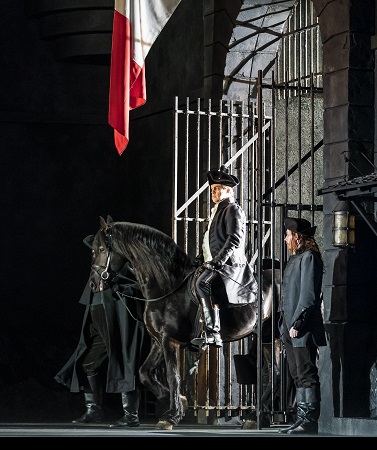 Simon Neal (Don Pizarro). Photo credit: Bill Cooper.
Simon Neal (Don Pizarro). Photo credit: Bill Cooper.
Thankfully, to counter such dramaturgical turbulence there was much fine singing from the stellar cast. Though apologies were made in advance for Jonas Kaufmann, who had not attended the final dress rehearsal due to ill health, the tenor still managed to communicate Florestan’s rapture, and hit those impossibly high climaxes; if ‘Gott! Welch’ Dunkel’ and the final reconciliation with Leonore were in any way underwhelming the fault lay with Kratzer who seemed to have offered little direction to his principals, so occupied was he with rewriting the Fidelio rule book. When Leonore released her husband - heralded by a beautiful oboe solo - in addition to some awkward blocking there were music-word non sequiturs in their rapturous duet, ‘O namenlose Freude!’: ‘Now I have you in my arms’ they may sing, but on this occasion Leonore and Florestan were yards apart and looking in different directions.
Georg Zeppenfeld was an engaging and warm-toned Rocco, more compelling and sympathetic than is sometimes the case with this role. Simon Neal was Robespierre through-and-through but struggled with the stratospheric demands that Beethoven requires of Pizarro. Amanda Forsythe was a clear-toned Marzelline, but she didn’t have the weight to carry Kratzer’s revisioning of the role. Similarly, Robin Tritschler’s Jaquino was vocally secure but dramatically non-descript. As Don Fernando, Egils Siliņš sang with sincerity but struggled, not surprisingly, to make a dramatic impact.
The day was saved, appropriately, by Lise Davidsen who shone and soared as Fidelio/Leonora. She has a vocal presence which absolutely compels. If only she had not been, repeatedly, a microsecond behind the beat, creating a sense of labouring when Leonore should fly. And, if only she’d been given more directorial assistance by Kratzer, whose only instruction seemed to have related to inappropriate unwrapping of Leonore’s chest bindings.
Antonio Pappano, conducting with a baton, unusually, was as insightful, alert to detail, and empathetic as always, but even the sterling playing of the ROH Orchestra could not overcome the directorial waywardness.
The prisoners’ chorus in Act 1 was magical but had no dramatic context in Kratzer’s account. The final redemptive chorus - as the present-day observers overwhelmed the upholders of the eighteenth-century state - which draws, sometimes verbatim, on Beethoven’s Cantata on the Death of Emperor Joseph II, should have bestowed order after the tumult of the prison scenes. Why did it not?
Well, Leonore may have triumphed with her ideals of hope, fidelity and honour, but Pizarro’s knife glinted still. Picked up by the disgruntled, unreconciled, alienated Jaquino, it seemed to create a crack in the opera’s visionary armour. Perhaps Kratzer’s vision of Fidelio had finally found a ‘truthful’ thread. In an 1998 essay, ‘Opera Opposed to Opera’, which considered the relationship between Così fan tutte and Fidelio, Edward Said remarks that, ‘Every affirmation … carries with it its own negation, just as every memory of love and conjugal fidelity also brings with it the danger and usually the actuality of something that will cancel it, annul it, obliterate it.’ Wise, and sad, words.
Claire Seymour
Jaquino - Robin Tritschler, Marzelline - Amanda Forsythe, Leonore - Lise Davidsen, Rocco - Georg Zeppenfeld, Don Pizzaro - Simon Neal, First Prisoner - Filipe Manu, Second Prisoner - Timothy Dawkins, Florestan - Jonas Kaufmann, Don Fernando - Egils Siliņš; Director - Tobias Kratzer, Conductor - Antonio Pappano, Designer - Rainer Sellmaier, Lighting Designer - Michael Bauer, Video Designer - Manuel Braun, Chorus and Orchestra of the Royal Opera House.
Royal Opera House, Covent Garden, London; Sunday 1st March 2020.
image=http://www.operatoday.com/ROH%20Fidelio%20title.jpg image_description= product=yes product_title= Beethoven’s Fidelio: a new production by Tobias Kratzer at Covent Garden product_by=A review by Claire Seymour product_id=Above: Fidelio at the Royal Opera HousePhoto credit: Bill Cooper
A sunny, insouciant Così from English Touring Opera
Not for Attridge the moral imperatives, psychological ‘proofs’ or ideological frameworks which some thrust upon Mozart and Da Ponte’s drama of abstract forces which drive human behaviour, which cannot be denied and should not be lamented. In an essay which considered the relationship between Così and Fidelio, Edward Said suggested that Così ‘refuse[s] the kind of metaphysical, or social, or cultural significance found readily by [various commentators] in Don Giovanni, Die Zauberflöte and Le nozze di Figaro’, and Attridge seems to agree.
“Out of a gothic North” we go “Southward into a sunburnt otherwhere”, said Auden in his poem ‘Good-Bye To The Mezzogiorno’, “some believing amore/ Is better down South and much cheaper”. And so Attridge transports us to 1930s Alexandria, then Egypt’s most cosmopolitan city, a beacon of Mediterranean culture and a gateway to Europe. That tolerant and inclusive city where the great, good and glamorous from far and wide - France, Italy, Greece, England, Armenia - mingled, in their chic bathing costumes, with Egyptian Jews and Muslims on ‘the sand beaches of Sidi Bishr’, as Lawrence Durrell described one such fashionable seafront watering-hole in his Alexandria Quartet.
Designer Oliver Townsend and Lighting Designer Mark Howland flood the small Empire stage with colour and sunlight. The crisp glare of the promenade where Don Alfonso, a English writer-abroad, lounges to pen his observations of the interlopers’ amorous antics, gives way to the cool blues and greens of a Neoclassical terrace. The emerald drapes, cobalt columns, gold patterned woodwork and hanging lanterns evoke leisured luxury: it’s a fitting arena for the lovers’ dalliances amid the alabaster statuary and palm plants.
Alfonso, sporting a white suit and panama, may be as cool in dress and as in manner, but the lovers are an explosion of colour. Their days are dedicated to fun and frolics. Indeed, the sunshine seems to have gone to their heads. Faces are flushed and hearts are febrile when ‘Dr Despina’ arrives to revive the ‘suicidal foreign lovers’, her medical apparatus producing Mesmer-like magnetic vibrations racier than is customary. The amused men throw themselves into the fiasco with a physical gusto which is more than matched by the concerned women. It’s hilarious and swiftly despatched. Farce at its best.
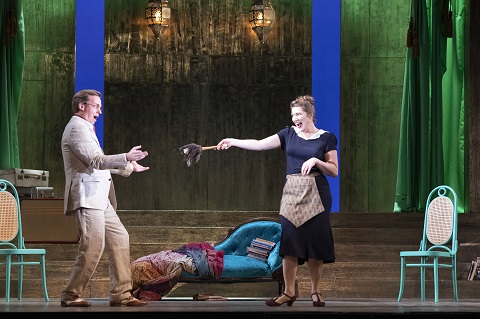 Stephan Loges (Don Alfonso) and Jenny Stafford (Despina). Photo credit: Richard Hubert Smith.
Stephan Loges (Don Alfonso) and Jenny Stafford (Despina). Photo credit: Richard Hubert Smith.
The cast are perfectly attuned to the blithe spirit of Attridge’s production. Martha Jones’ Dorabella, flamboyantly attired in a glorious green trouser-dress, grasps her romantic opportunities with relish, and confesses all in a beautifully sonorous ‘È amore un ladroncello’, looking and sounding not the least regretful as she reveals her indiscretions to Fiordiligi. Joanna Marie Skillett is a more demure Fiordiligi, attempting to defy the amatory sunstroke that afflicts the other lovers, but passion drives the precision of both ‘Come scoglio’ and ‘Per pietà’. As she pleads with herself to resist temptation and moral taint, her sincerity is undermined by some gentle but pointed horn commentary.
I admired Tom Elwin’s Nemorino last summer, in Into Opera’s L’elisir , and here he was a vocally elegant Ferrando, his diction, like that of all the cast, excellent - enabling us to enjoy the insinuations, double entendres and wry couplets of Jeremy Sams’ English translation. Frederick Long sang with a lovely fresh and relaxed tone as Guglielmo, dashing in his knee-boots and flying suit as he swept Dorabella to the clouds.
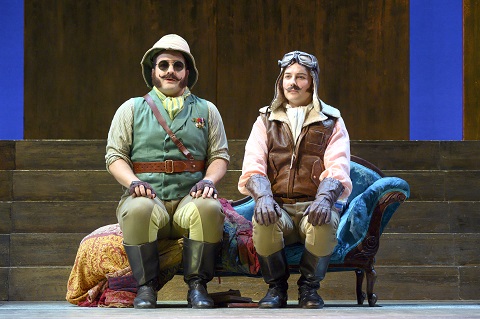 Thomas Elwin (Ferrando) and Frederick Long (Guglielmo). Photo credit: Richard Hubert Smith.
Thomas Elwin (Ferrando) and Frederick Long (Guglielmo). Photo credit: Richard Hubert Smith.
As Despina, Jenny Stafford demonstrated the same comic timing and vocal grace that have impressed several times at Bampton Classical Opera . Stephan Loges evinced Don Alfonso’s worldly-wise weariness, lounging with a lazy lethargy which was complemented by the languidly uncoiling smoke of his cigarette, but his cool cynicism did not deprive the recitatives of their cutting impact.
There was a sense of caution in some of the ensembles. This is understandable at the start of a long tour, but was also a result of some uncertainty, of tempo and tuning, from the Old Street Band in the pit. Conductor Holly Mathieson got the show on the road with a crisp overture, but elsewhere a bit more zip and drive was needed.
Lawrence Durrell claimed that in the Alexandria Quartet ‘only the city is real’. And, that spirit of amoral fantasy imbued this Così . There was no gravity, no guilt, no emotional shipwrecks. As Despina says, “Quello ch’è stato, è stato,/ Scordiamci del passato.” What’s done is done and the less said the better.
“Wish you were here!” proclaims the picture-postcard front drop. Audiences around the country certainly will wish they were!
Claire Seymour
Mozart: Così fan tutte
Fiordiligi - Joanna Marie Skillett, Ferrando - Thomas Elwin, Dorabella - Martha Jones, Guglielmo - Frederick Long, Stephan Loges - Don Alfonso, Despina - Jenny Stafford; Director - Laura Attridge, Conductor - Holly Mathieson, Designer - Oliver Townsend, Lighting Designer - Mark Howland.
English Touring Opera, Hackney Empire, London; Saturday 29th February 2020.
image=http://www.operatoday.com/ETO%20Cosi%20title.jpg image_description= product=yes product_title=English Touring Opera 2020 spring tour: Così fan tutte at the Hackney Empire product_by=A review by Claire Seymour product_id=Above: Così fan tuttePhoto credit: Richard Hubert Smith